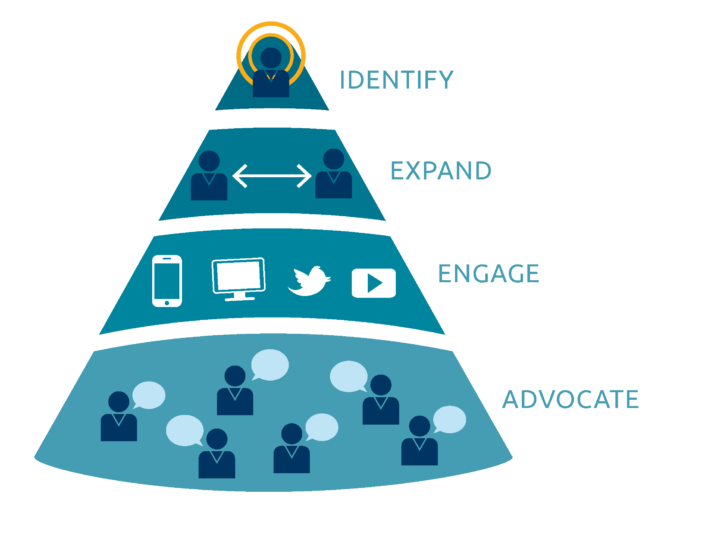An account-based marketing funnel is a tool that treats individual prospects or customer accounts as markets of their own. It focuses on targeting and engaging specific high-value accounts, rather than casting a wide net to a broader audience.
As a result, it creates alignment between sales, marketing, and customer success teams by making sure they are all focused on reaching out to customers effectively. It is a way to visualize and measure the progress of your marketing efforts for individual accounts.
ABM metrics provide a clear way to measure the impact of account-based efforts.
Digital marketing and analytics have revolutionized the ability of marketers to reach a wide range of customers. However, this has also highlighted that not all leads generated are necessarily an ideal fit for businesses.
With account-based marketing, you can get more out of your customer base by targeting specific accounts with tailored content and personalized campaigns.
This guide will show you how to build an ABM funnel that will produce results and provide tips on measuring your ABM funnel’s success and making necessary changes based on the data collected.
Key Takeaways
- Unlike the traditional sales funnel, the ABM funnel starts with account selection, emphasizing engagement, conversion, and retention. It provides a more comprehensive view of the buyer’s journey, considering engagement and retention as crucial elements.
- The ABM funnel introduces a more comprehensive view of the buyer’s journey. This acknowledges the complexity of the modern buyer’s journey and highlights the importance of nurturing relationships beyond the initial sale.
- The ABM approach heavily relies on data and insights for account identification, expansion, engagement, and advocacy, stressing the importance of real-time data for effective B2B market segmentation and account selection.
What is an Account-Based Marketing Funnel?
The account-based marketing funnel is a targeted sales and marketing framework that focuses on engaging high-value accounts through a personalized, multi-stage approach—starting with account selection, followed by tailored engagement, nurturing, and conversion.
It prioritizes quality over quantity, ensuring that marketing efforts are concentrated on the most promising accounts to drive higher conversion rates and long-term business growth.
We can understand ABM funnels better if we know the basics of account-based marketing.
Understanding Account-Based Marketing

Account-based marketing is a targeted approach to marketing in which you customize your outreach and messaging to appeal to specific high-ticket accounts. The goal is not just generating leads but nurturing those relationships until they result in closed deals.
The Role of the Funnel in Account-Based Marketing Strategy
The ABM funnel can help you track your progress throughout the sales cycle, from initial awareness through conversion. Using this information, you can also determine where your strategy needs to be adapted for future success.
An account-based marketing approach requires a different mindset than traditional lead-based marketing. With ABM, you are focused on quality over quantity. You want to secure that you reach the right people at the right companies with the right message.
Stages of the Account-Based Marketing Funnel
As a data-driven marketing approach, ABM relies on account intelligence and insights to identify, expand, engage, and advocate your most valuable accounts.
Its four basic stages are as follows:
Stage 1: Identify
You identify your target accounts in the ABM funnel’s first stage.
This involves leveraging data and insights to pinpoint companies that are more likely to benefit from the product or service being offered. Through a combination of demographic, firmographic, and behavioral data, marketers aim to create a comprehensive list of potential accounts that represent the best fit for their solutions.

It requires market segmentation and account selection. Once you’ve identified your target accounts, you need to generate leads and segment all qualified accounts.
For this, you must answer several key questions, such as:
- What characteristics do these companies share?
- Are there any specific pain points they have that my product or service can address?
- How large are these companies?
- Are they actively engaged in solving this problem?
Stage 2: Expand
Once the target accounts are identified, you expand your reach within the target account.

This stage often involves researching and profiling individuals within the target accounts, understanding their challenges, and mapping out the relationships and influencers within the organization. The goal is to gain a holistic view that goes beyond basic demographics, enabling more personalized and targeted engagement strategies.
Stage 3: Engage
In the third stage of the ABM funnel, engage your target accounts with hyper-personalized content and messages. You build relationships with decision-makers and influencers through one-to-one interactions.
When you’re trying to engage with decision-makers, it’s important to remember that they’re probably very busy people. You need to engage with them in a way that is respectful of their time and meets their needs.

Start by getting a good sense of what they’re looking for. Then, reach out to them and provide helpful information relevant to their needs. Once you’ve established a rapport, stay in touch and continue to provide value.
Doing this will build strong relationships with decision-makers, leading to new business opportunities.
Stage 4: Advocate
In the final stage of the funnel, you turn your target accounts into advocates for your brand. You create loyalty and evangelism by providing an outstanding customer experience. Advocates are customers willing to serve as references or promote your brand to their networks.

To turn your target accounts into advocates, you must deliver an exceptional customer experience at every touchpoint. It includes pre-sale interactions, such as marketing and sales communications, and post-sale interactions, such as customer support and success.
Marketing and sales teams should design every interaction to create a positive impression that will encourage customers to recommend your brand to others.
How Does the Traditional Funnel Differ from the New ABM Funnel?
The traditional sales funnel is a time-tested way of managing the sales process, from generating leads to closing deals. This model starts with awareness and moves through interest, desire, and action.
However, because it is too linear, one of the biggest drawbacks is that it can be rigid and inflexible. It doesn’t consider the complexities of the modern buyer’s journey, making it difficult to adapt to changing customer needs or market conditions.
According to Forrester Research, “ABM is not a new form of marketing, but rather a fundamental shift in how marketers approach and operate their programs.”
The ABM funnel starts with account selection and moves through engagement, conversion, and retention. This model considers buyers more likely to convert when they’re already engaged with a company.
The new model emphasizes the importance of retaining customers once they’ve been converted. The new ABM funnel provides a more holistic view of the buyer’s journey by focusing on engagement and retention.
Characteristics of an ABM Funnel
There are a few key characteristics of an ABM Funnel that make it different from other types of marketing funnels.
Here are a few things:
The focus is on quality, not quantity.
With ABM, the goal is to identify and target high-value accounts that are highly likely to become customers. You might have fewer prospects in your funnel, but they will be higher-quality leads.
The buying process is more complex.
Because you’re targeting specific companies with an ABM approach, the sales process will be more complex than if you were just selling to individual consumers.
Your funnel will need to be longer and more detailed to account for the multiple decision-makers within each target account.
You need account intelligence.
To be successful with ABM, you need to have a deep understanding of your target key accounts. It requires extensive research and data analysis. Generating leads or converting prospects into customers will be difficult without these insights.
It is a team effort.
Success with ABM requires buy-in and collaboration from multiple departments within your company, including sales, marketing, and customer success. You’ll need strong communication and project management skills to keep everyone on the same page.
Who is ABM for?
So who can best benefit from ABM?
ABM is ideal for B2B companies of all sizes and industries that have complex, long, and high-value sales cycles with multiple decision-makers and influencers. ABM is particularly effective for enterprise-level companies that sell to high-value accounts and need to build strong relationships with them.
If you’re selling products or services that require a significant investment from your buyers, then ABM can be an extremely effective way to close more business.
It is also suitable for mid-market companies that have a targeted and scalable approach to sales and marketing. If you’re a B2B company that wants to focus on quality over quantity, ABM is for you.
But ABM can also benefit businesses with a small number of target accounts. Because ABM is a more personalized and targeted approach, it can help engage the decision-maker within these companies.
How to Implement an Account-Based Marketing Strategy
Now that you know what account-based marketing is and who can benefit from it, let’s look at how you can implement an ABM strategy.
Define Your Target Accounts
The first step is identifying the companies you want to target with your ABM campaigns. To do this, you’ll need to create a profile of your ideal customer. Consider factors such as size, location, industry, and budget. You should also research each company to see if they need your product or service.
Create Targeted Campaigns
Once you’ve defined your target accounts, you can start to create campaigns specifically for them. To do this effectively, you’ll need to understand each company’s needs and pain points. It requires extensive research and data analysis.
Engage Decision-Makers
The next step is to engage the decision-makers within your target accounts. Sales reps can do it through various channels, such as email, direct mail, or even events and conferences. The goal is to generate interest and start a conversation with these individuals.
Automate and Scale Your ABM Efforts
Invest in technology and tools to help you automate and scale your ABM efforts. It includes lead tracking, account-based advertising, and customer relationship management (CRM) software. By automating your processes, you’ll be able to free up time to focus on other aspects of your business.
Measure Success
The final step is to measure the success of your campaigns. It can be done by tracking key metrics, such as the number of leads generated or the number of deals closed. By tracking these metrics, you’ll see which campaigns are performing well and which need improvement.
Account-Based Marketing Funnel Metrics
ABM Funnel Metrics is a set of key performance indicators (KPIs) that companies use to track and measure progress at each stage of the account-based marketing funnel.
There are a few key metrics that you should track when it comes to your ABM funnel:
- First, you need to track the number of leads that enter your funnel. It will give you an idea of how effectively your marketing campaigns generate interest.
- Second, you need to track conversion rates at each funnel stage. It will help you identify bottlenecks and areas for improvement.
- Third, you need to track the lifetime value of each customer. It is important because it will show you how much revenue your average customer generates over time.
- Fourth, you need to track churn rates. It is important because it will show how many customers are leaving your service.
- Finally, you need to track the number of deals closed. It is the most important metric, as it will show you how effectively your ABM funnel generates new business.
By tracking these metrics, you’ll see which parts of your funnel are performing well and which need improvement. By doing this, you’ll be able to optimize your funnel and generate more leads, conversions, and closed deals.
Account-Based Marketing Tools
Here are six essential account-based marketing tools:
- A CRM system: A CRM system is essential for managing your contacts and accounts. It will help you keep track of your interactions with each account and ensure you’re following up at the right time.
- Data and analytics: Good data is essential for success with ABM. You need to track which marketing and sales activities are working and where you need to adjust your strategy. Analytics will also help you measure results and ROI.
- Marketing automation platform: A good marketing automation platform will help you automate repetitive tasks like email marketing and lead nurturing.
- Social Media Listening Tool: A social media listening tool will help you track what’s being said about your brand and your competitors. This information can be used to adjust your account-based marketing tactics.
- Account-based advertising: Account-based advertising is targeted online advertising that allows you to reach your ideal customers with laser precision and run a successful ABM campaign.
- The right mix of digital and traditional channels: You need to reach your target accounts through their channels. That means a mix of digital and traditional channels, such as email, LinkedIn, direct mail, and events.
- A dedicated ABM team: ABM is a team sport, so you need dedicated sales and marketing teams to make it happen. This team should include people with expertise in sales, marketing, and technology.
The Role of Sales and Marketing Teams in an ABM Plan

What are the responsibilities of a sales team?
A sales team plays a vital role in any account-based marketing (ABM) plan. The sales team is responsible for identifying and targeting key accounts, developing relationships with decision-makers, and ultimately closing deals.
To succeed, a sales team must have a deep understanding of the buyer persona and the specific needs of the target account. They must be able to craft compelling messages that align with the overall ABM strategy.
The sales team must also work closely with other marketing team members to ensure that all touchpoints are coordinated and that the overall plan is executed flawlessly.
What are the responsibilities of a marketing team?
The marketing team is responsible for creating and executing the marketing strategy.
This includes identifying the target market, crafting messaging that resonates with the target market, designing campaigns that reach the target market, and measuring results to optimize future efforts.
The marketing team takes on additional responsibilities to ensure that accounts are accurately targeted and that personalized campaigns are delivered to each account. The ultimate goal of ABM is to generate more qualified leads and close more deals, so the marketing team plays a critical role in driving success.
When both teams collaborate effectively, it creates a cohesive account-based experience that aligns every interaction—from the first touchpoint to post-sale engagement—with the unique needs of each account.
Conclusion
An effective ABM funnel is key to generating new business. You can optimize your funnel by tracking essential metrics and seeing increased leads, conversions, and closed deals. To be successful with ABM, you need a sales team that understands the buyer persona and the needs of the target account, as well as a marketing team that can create and execute a coordinated plan. When all the pieces come together, an account-based marketing funnel can be a powerful tool for driving new business.
FAQs
Here are other questions related to the Account-Based Marketing Funnel that we have not discussed in the article.
What is an Account-Based Marketing Framework
An account-based marketing framework is a structured marketing approach designed to generate more leads and sales from your target key accounts. The framework focuses on developing a deep understanding of your target accounts, identifying the key decision-makers within those accounts, and tailoring your marketing messages and activities to appeal to those specific individuals.
The account-based marketing framework can be adapted to any size business and is particularly well-suited for businesses that sell complex products or services to large organizations. The account-based marketing framework can help you close more deals and grow your business faster when executed effectively.
What is the Difference Between Account-Based Marketing and Inbound Marketing?
There are two principal marketing approaches: account-based marketing (ABM) and inbound marketing. ABM entails developing laser-focused relationships with specific accounts most likely to do business.
On the other hand, inbound marketing is a more broad-based approach that relies heavily on content marketing to attract strangers and turn them into leads and then customers.
So, which is the better strategy? It depends on your situation. ABM may be the way to go if you sell to large enterprises since these deals involve multiple decision-makers. However, if you target small businesses or consumers, then inbound marketing may be a better option since it is less expensive and easier to scale.
What is the ABM Process
ABM Process involves six primary steps:
1. strategizing
2. identifying buying committees
3. target account selection
4. creating personalized media plans
5. deploying tactics
6. measuring success